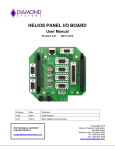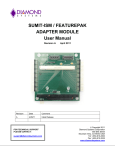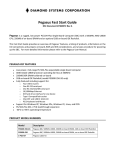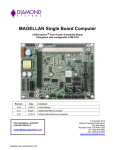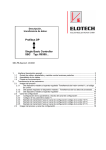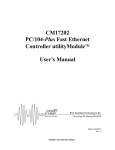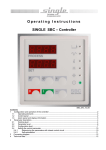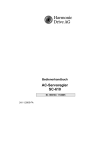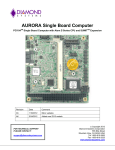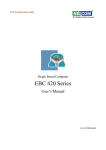Download Diamond Corona Specifications
Transcript
Corona SUMIT-ISM Wireless and Ethernet Communications Module Revision A.11 Revision Date A 12/13/2010 Initial Release A.1 2/8/2012 Rev B Update A.11 12/3/2012 Minor updates FOR TECHNICAL SUPPORT PLEASE CONTACT: [email protected] December 2012 Comment Copyright 2012 Diamond Systems Corporation 555 Ellis Street Mountain View, CA 94043 USA Tel 1-650-810-2500 Fax 1-650-810-2525 www.diamondsystems.com CONTENTS 1. 2. Important Safe Handling Information .............................................................................................................3 Introduction .......................................................................................................................................................4 2.1 Features .........................................................................................................................................................4 2.2 SUMIT Socket Resources .............................................................................................................................5 2.3 Cable Kit ........................................................................................................................................................5 3. Functional Overview .........................................................................................................................................6 3.1 Functional Block Diagram ..............................................................................................................................6 3.2 WiFi Module ...................................................................................................................................................7 3.3 PLX PEX8112 PCIe to PCI Bridge Chip ........................................................................................................7 3.4 Dual 10/100 USB LAN Controllers ................................................................................................................7 3.5 Chrontel CH7317B SDVO to VGA Controller ................................................................................................7 4. Board Outline and Layout ................................................................................................................................8 4.1 Corona Board Drawing ..................................................................................................................................8 5. Connector AND Jumper List ......................................................................................................................... 10 6. Connector and Jumper Pinout and Pin Description .................................................................................. 11 6.1 PC/104 Connector (J1, J2) ......................................................................................................................... 11 6.2 Mini-PCI Connector (J3) ............................................................................................................................. 12 6.3 USB2 and USB3 (J4) .................................................................................................................................. 13 6.4 LAN 1 and 2 Ports (J5, J6) ......................................................................................................................... 13 6.5 SDVO Video Input (J7) ............................................................................................................................... 14 6.6 VGA Video Output (J8) ............................................................................................................................... 14 6.7 PCIe Routing Jumper (J13) ........................................................................................................................ 15 6.8 SUMIT-A Expansion Bus (J11) ................................................................................................................... 16 7. Installation and configuration ...................................................................................................................... 17 7.1 Attaching Corona to the Aurora SBC ......................................................................................................... 17 7.2 Attaching External Antennas to the WiFi Module ....................................................................................... 17 7.3 Installing WiFi Drivers ................................................................................................................................. 17 8. Specifications................................................................................................................................................. 18 CORONA User Manual Rev A.11 www.diamondsystems.com Page 2 1. IMPORTANT SAFE HANDLING INFORMATION WARNING! ESD-Sensitive Electronic Equipment Observe ESD-safe handling procedures when working with this product. Always use this product in a properly grounded work area and wear appropriate ESD-preventive clothing and/or accessories. Always store this product in ESD-protective packaging when not in use. Safe Handling Precautions The Corona board contains a high density connector with many connections to sensitive electronic components. This creates many opportunities for accidental damage during handling, installation and connection to other equipment. The list here describes common causes of failure found on boards returned to Diamond Systems for repair. This information is provided as a source of advice to help you prevent damaging your Diamond (or any vendor’s) embedded computer boards. ESD damage – This type of damage is usually almost impossible to detect, because there is no visual sign of failure or damage. The symptom is that the board eventually simply stops working, because some component becomes defective. Usually the failure can be identified and the chip can be replaced. To prevent ESD damage, always follow proper ESD-prevention practices when handling computer boards. Damage during handling or storage – On some boards we have noticed physical damage from mishandling. A common observation is that a screwdriver slipped while installing the board, causing a gouge in the PCB surface and cutting signal traces or damaging components. Another common observation is damaged board corners, indicating the board was dropped. This may or may not cause damage to the circuitry, depending on what is near the corner. Most of our boards are designed with at least 25 mils clearance between the board edge and any component pad, and ground / power planes are at least 20 mils from the edge to avoid possible shorting from this type of damage. However these design rules are not sufficient to prevent damage in all situations. A third cause of failure is when a metal screwdriver tip slips, or a screw drops onto the board while it is powered on, causing a short between a power pin and a signal pin on a component. This can cause overvoltage / power supply problems described below. To avoid this type of failure, only perform assembly operations when the system is powered off. Sometimes boards are stored in racks with slots that grip the edge of the board. This is a common practice for board manufacturers. However our boards are generally very dense, and if the board has components very close to the board edge, they can be damaged or even knocked off the board when the board tilts back in the rack. Diamond recommends that all our boards be stored only in individual ESD-safe packaging. If multiple boards are stored together, they should be contained in bins with dividers between boards. Do not pile boards on top of each other or cram too many boards into a small location. This can cause damage to connector pins or fragile components. Power supply wired backwards – Our power supplies and boards are not designed to withstand a reverse power supply connection. This will destroy each IC that is connected to the power supply (i.e. almost all ICs). In this case the board will most likely will be unrepairable and must be replaced. A chip destroyed by reverse power or by excessive power will often have a visible hole on the top or show some deformation on the top surface due to vaporization inside the package. Check twice before applying power! Overvoltage on analog input – If a voltage applied to an analog input exceeds the design specification of the board, the input multiplexor and/or parts behind it can be damaged. Most of our boards will withstand an erroneous connection of up to 35V on the analog inputs, even when the board is powered off, but not all boards, and not in all conditions. Overvoltage on analog output – If an analog output is accidentally connected to another output signal or a power supply voltage, the output can be damaged. On most of our boards, a short circuit to ground on an analog output will not cause trouble. Overvoltage on digital I/O line – If a digital I/O signal is connected to a voltage above the maximum specified voltage, the digital circuitry can be damaged. On most of our boards the acceptable range of voltages connected to digital I/O signals is 0-5V, and they can withstand about 0.5V beyond that (-0.5 to 5.5V) before being damaged. However logic signals at 12V and even 24V are common, and if one of these is connected to a 5V logic chip, the chip will be damaged, and the damage could even extend past that chip to others in the circuit. CORONA User Manual Rev A.11 www.diamondsystems.com Page 3 2. INTRODUCTION Corona is a SUMIT-ISM form factor wireless and Ethernet Communications module with SUMIT-A and PC/104 (ISA) expandability. High Power Output Diamond’s Corona SUMIT Communications module offers high powered performance in a compact form factor, with peak wireless power up to 600mW. The on-module heatsink assures consistent power output. Designed for Outdoor Applications Corona was designed with outdoor applications in mind. It is ideal for access point applications or a wide range of other embedded computing applications. Rugged and Robust Extended temperature operation of -40°C to +85°C is tested and guaranteed. The mini-PCI wireless module mounts securely to the carrier through a standoff and screw. Expandability The Corona SUMIT Communications module has both SUMIT-A and PC/104 (ISA) stackthrough expandability. Therefore it can be used in legacy PC/104 stacks as well as new SUMIT-based architectures. 2.1 Features WiFi module 802.11a/b/g mini-PCI wireless LAN Up to 108Mbps transmit & receive rates Average power up to 23dBm Peak power up to 28dBm Reliable high radio power Module secured to carrier board I/O Dual on-board 10/100Base-T Ethernet ports Dual USB 2.0 Ports SDVO to VGA Converter Miscellaneous SUMIT-A and PC/104 (ISA) stackable expansion Extremely rugged -40°C to +85°C (-40°F to +185°F) operating temperature WiFi support for Windows XP and Linux CORONA User Manual Rev A.11 www.diamondsystems.com Page 4 2.2 SUMIT Socket Resources Corona’s SUMIT-A expansion socket uses the resources indicated in the table below. For further details on the SUMIT expansion standard, visit SFF-SIG.org/sumit.html. 2.3 Cable Kit A cable kit, C-COR-KIT, is available for Corona. It contains the cables in the following table. Part Number Quantity Description 6981080 2 Ethernet cable, 2mm 2x5 crimp to RJ-45 socket 6981082 1 Dual USB cable, 2mm 2x5 to Dual USB 6981084 1 VGA cable, 2mm 2x5 crimp to DD15F CORONA User Manual Rev A.11 www.diamondsystems.com Page 5 3. FUNCTIONAL OVERVIEW 3.1 Functional Block Diagram Block Diagram coax PCIe x1 PLX PEX8112 PCI Wireless LAN SUMIT – A +3.3V Connector Voltage Regulator USB0 USB LAN Controller Magnetics 10/100 Ethernet USB1 USB LAN Controller Magnetics 10/100 Ethernet USB 2, 3 SDVO Connector SDVO to VGA Analog Level Shifters Analog VGA The Corona SUMIT Communications module features both wireless and networking connectivity in the SUMITISM Type I form factor. The product contains a WiFi card connected via a mini-PCI socket, two 10/100Base-T Ethernet ports, two USB 2.0 ports if supported by the host system, an SDVO to VGA converter, and both a SUMIT-A connector and a PC104 (ISA) connector for expansion. The wireless WiFi card is a mini-PCI IEEE 802.11 wireless LAN. Its average power is up to 200mW with peak power up to 600mW. The on-board dual 10/100Base-T Ethernet ports provide a high speed option for communication with remote hosts. The SDVO to VGA converter takes an externally provided SDVO input and converts it to an analog VGA output. It is designed for use with Diamond’s Aurora single board computer. CORONA User Manual Rev A.11 www.diamondsystems.com Page 6 3.2 WiFi Module The WiFi module is an industrial grade, high power 600mW (28dBm) IEEE802.11a/b/g 108Mbps Wifi mini-PCI module with two U.FL RF connectors designed specifically for operation in high temperature and high performance-critical applications. With industrial grade components and a high power design, the module is ideal for embedding into new or existing industrial grade systems for rugged outdoor point to point or building to building wireless Access Point/Bridge connections, and rugged application-specific devices used in many vertical markets. 3.3 PLX PEX8112 PCIe to PCI Bridge Chip The PEX 8112 supports forward and reverse bridging as defined by the PCI Express-to-PCI/PCI-X Bridge Specification 1.0. In forward mode, the bridge allows legacy PCI chips and adapters to be used with new PCI Express processor systems. PCIE Interface PCI Express Base 1.0a compliant X1 Link, dual-simplex, 2.5Gbps per direction Automatic LVDS polarity reversal PCI Interface PCI v.3.0: 32bit, up to 66Mhz 3.3VI/O and 5V tolerant PCI Provides PCI clock output 3.4 Dual 10/100 USB LAN Controllers Single Chip Hi-Speed USB 2.0 to 10/100 Ethernet Controller Integrated 10/100 Ethernet MAC with Full Duplex and HP Auto-MDX support Integrated USB 2.0 High Speed PHY and Device Controller +/- 8kV HBM ESD protection (component level) +/- 8kV contact-discharge, +/-15kV air discharge ESB protection per IEC61000-4-2 3.5 Chrontel CH7317B SDVO to VGA Controller Supporting analog RGB outputs for a display monitor Supporting maximum pixel rate of 165MP/s or graphics resolutions up to 1920x1200 High-speed SDVO (1G~2Gbps) AC-coupled serial differential RGB inputs Supporting monitor connection detection CORONA User Manual Rev A.11 www.diamondsystems.com Page 7 4. BOARD OUTLINE AND LAYOUT 4.1 Corona Board Drawing The following diagram shows locations for all connectors identified in the next section. Corona Top CORONA User Manual Rev A.11 www.diamondsystems.com Page 8 Corona Bottom CORONA User Manual Rev A.11 www.diamondsystems.com Page 9 5. CONNECTOR AND JUMPER LIST The following table summarizes the functions of Corona’s interface connectors and jumpers. Please refer to the drawings in Section 4 for the locations of these connectors and jumpers on Corona. Signal functions relating to all of Corona’s interface connectors and jumpers are discussed in greater detail in Section 6 of this document. Other connectors and jumper blocks on Corona are reserved for Diamond’s use only. Connector J1 64 pin 40 ISA connector J2 40 pin ISA connector J3 Mini PCI connector J4 USB2, 3 connectors J5 LAN1 Ethernet pin header J6 LAN2 Ethernet pin header J7 SDVO video input connector J8 VGA output connector J11 SUMIT-A connector top side J12 SUMIT-A connector bottom side Jumper J13 CORONA User Manual Rev A.11 Function Function PCIe routing www.diamondsystems.com Page 10 6. CONNECTOR AND JUMPER PINOUT AND PIN DESCRIPTION 6.1 PC/104 Connector (J1, J2) The PC/104 bus is essentially identical to the ISA bus except for the physical design. It specifies two pin and socket connectors for the bus signals. A 64-pin connector, J1, incorporates the 64-pin 8-bit bus connector signals, and a 40-pin connector, J2, incorporates the 36-pin 16-bit bus connector signals. The additional pins on the PC/104 connectors are used as ground or key pins. The female sockets on the top of the board enable stacking another PC/104 board on top of Corona, while the male pins on the bottom enable the board to plug into another board below it. The PC/104 bus connector pinout and signal functions are defined by the latest version of the PC/104 Consortium's “PC/104 Specification” (see http://www.pc104.org). In the pinout figures below, the tops correspond to the left edge of the connector when the board is viewed from the primary side (side with the miniPCI connector and the female end of the PC/104 connector) and the board is oriented so that the PC/104 connectors are along the bottom edge of the board. J2: PC/104 16-bit bus connector J1: PC/104 8-bit bus connector IOCHK- A1 B1 Ground Ground C0 D0 Ground SD7 A2 B2 RESET SBHE- C1 D1 MEMCS16- SD6 A3 B3 +5V LA23 C2 D2 IOCS16- SD5 A4 B4 IRQ9 LA22 C3 D3 IRQ10 SD4 A5 B5 -5V LA21 C4 D4 IRQ11 SD3 A6 B6 DRQ2 LA20 C5 D5 IRQ12 SD2 A7 B7 -12V LA19 C6 D6 IRQ15 SD1 A8 B8 OWS- LA18 C7 D7 IRQ14 SD0 A9 B9 +12V LA17 C8 D8 DACK0- IOCHRDY A10 B10 KEY MEMR- C9 D9 DRQ0 AEN A11 B11 SMEMW-W MEMW- C10 D10 DACK5- SA19 A12 B12 SD8 C11 D11 DRQ5 SA18 A13 B13 SD9 C12 D12 DACK6- SA17 A14 B14 SD10 C13 D13 DRQ6 SA16 A15 B15 SD11 C14 D14 DACK7- SA15 A16 B16 SD12 C15 D15 DRQ7 SA14 A17 B17 SD13 C16 D16 +5V SA13 A18 B18 SD14 C17 D17 MASTER- SA12 A19 B19 SD15 C18 D18 Ground SA11 A20 B20 SYSCLK KEY C19 D19 Ground SA10 A21 B21 IRQ7 SA9 A22 B22 IRQ6 SA8 A23 B23 IRQ5 SA7 A24 B24 IRQ4 SA6 A25 B25 IRQ3 SA5 A26 B26 DACK2- SA4 A27 B27 TC SA3 A28 B28 BALE SA2 A29 B29 +5V SA1 A30 B30 OSC SA0 A31 B31 Ground Ground A32 B32 Ground CORONA User Manual Rev A.11 SMEMRIOWIORDACK3DRQ3 DACK1DRQ1 REFRESH- www.diamondsystems.com Page 11 Connector type: Connectors J1 and J2 provide a standard PC/104 ISA stackable expansion bus. There is no PC/104 functionality on Corona. This board simply passes-through the signals of the PC/104 bus. 6.2 Mini-PCI Connector (J3) Mini-PCI Card Type Ill, System Connector Pinout Pin I 3 5 7 9 11 13 15 17 19 21 23 25 27 29 31 33 35 37 39 41 43 45 47 49 51 53 55 57 59 61 Signal TIP Key 8PMJ-3 8PMJ-6 8PMJ-7 8PMJ-8 LED1_GRNP LED1_GRNN CHSGND INTB# 3.3V RESERVED GROUND CLK GROUND REQ# 3.3V AD[31] AD[29] GROUND AD[27] AD[25] RESERVED C/BE[3]# AD[23] GROUND AD[21] AD[19] GROUND AD[17] C/BE[2]# IRDY# Connector type: Pin 2 4 6 8 10 12 14 15 18 21 22 24 26 28 30 32 34 36 38 40 42 44 46 48 50 52 54 56 58 60 62 Signal RING Key 8PMJ-1 8PMJ-2 8PMJ-4 8PMJ-5 LED2_YELP LED2_YELN RESERVED 5V INTA# RESERVED 3,3VAUX RST# 3.3V GNT# GROUND PME# RESERVED AD[30] 3.3V AD[28] AD[26] AD[24] IDSEL GROUND AD[22] AD[20] PAR AD[18] AD[16] GROUND Pin 63 65 67 69 71 73 75 77 79 81 83 85 87 89 91 93 95 97 99 101 103 105 107 109 111 113 115 117 119 121 123 Signal 3.3V CLKRUN# SERR# GROUND PERR# C/BE[1]# AD[14] GROUND AD[12] AD[10] GROUND AD[08] AD[07] 3.3V AD[05] RESERVED AD[03] 5V AD[01] GROUND AC_SYNC AC_SDATA_IN AC_BIT_CLK AC_CODEC_ID1# MOD_AUDIO_MON AUDIO GND SYS_AUDIO_OUT SYS_AUDIO_OUT GND AUDIO_GND RESERVED VCC5VA Pin 64 66 68 70 72 74 76 78 80 62 84 86 88 90 92 94 96 98 100 102 104 106 108 110 112 114 116 118 120 122 124 Signal FRAME# TRDY# STOP# 3.3V DEVSEL# GROUND AD[15] AD[13] AD[11] GROUND AD[09] C/BE[0]# 3.3V AD[06] AD[04] AD[02] AD[00] RESERVED_WIP RESERVED_WIP GROUND M66EN AC_SDATA_OUT AC_CODE_ID0# AC_RESET# RESERVED GROUND SYS_AUDIO_IN SYS_AUDIO_IN GND AUDIO_GND MPCIACT# 3.3VAUX Mini-PCI Card Type III CORONA User Manual Rev A.11 www.diamondsystems.com Page 12 6.3 USB2 and USB3 (J4) Corona features two USB 2.0 ports on a pin header. Connector J4 interfaces to USB ports 2 and 3. USB 2.0 provides a 480Mbps maximum data transfer rate. The shield pin is tied to system ground. Diamond Systems’ cable number 6981082 mates with this connector. These USB signals are driven by the host system that Corona is connected to. Therefore these USB ports are dependent upon the host to provide the signals. Some host systems may only provide one USB port to this connector; others none at all. Key Ground USB2 Data+ USB2 DataPower+ 1 3 5 7 9 2 4 6 8 10 Ground Ground USB3 Data + USB3 DataPower+ 1 Connector type: 2x5 standard 2mm dual row straight pin header with gold flash plating 6.4 LAN 1 and 2 Ports (J5, J6) Dual 10/100 Base-T, full-duplex Ethernet interfaces are provided by connectors J5 and J6. Diamond Systems’ cable number 6981084 mates with these connectors. N/A RX+ TX+ N/A N/A 1 3 5 7 9 2 4 6 8 10 Key RXTXN/A N/A 1 Connector type: 2x5 standard 2mm dual row straight pin header with gold flash plating. CORONA User Manual Rev A.11 www.diamondsystems.com Page 13 6.5 SDVO Video Input (J7) Connector J7 is used to bring SDVO video in for the purposes of conversion to VGA output. This connector mates to a corresponding connector on Diamond’s Aurora single board computer. 1 SDVO_B_BLUE# 2 BUF_PLT_RST# 3 SDVO_B_BLUE 4 Ground 5 Ground 6 SDVO_B_GREEN# 7 SDVO_CTRLCLK 8 SDVO_B_GREEN 9 SDVO_CTRLDATA 10 Ground 11 Ground 12 SDVO_B_CLK_N 13 +3.3V 14 SDVO_B_CLK_P 15 +3.3V 16 Ground 17 +5V 18 SDVO_B_RED# 19 +5V 20 SDVO_B_RED Connector type: 20 pin Samtec stacking connector ERF8-010-07.0-L-DV-TR 6.6 VGA Video Output (J8) Connector J8 is used to connect a VGA monitor. Although the DDC serial detection pins are present, a 5V power supply is not provided, and the legacy “Monitor ID” pins are also not used. Diamond Systems’ cable number 6981084 mates with this connector. RED GREEN BLUE HSYNC VSYNC 1 3 5 7 9 2 4 6 8 10 Ground Key Ground DDC-Data DDC-Clock 1 Connector type: 2x5 standard 2mm dual row straight pin header with gold flash plating CORONA User Manual Rev A.11 www.diamondsystems.com Page 14 6.7 PCIe Routing Jumper (J13) Jumper block, J13, determines the PCIe bus routing on Corona. The default setting routes the PCIe bus to the PLX switch for the mini-PCI WiFi module. For applications not using the WiFi module, the PCIe bus can be rerouted to the SUMIT-A connector and passed up the stack. Pins 7 and 8 on jumper block J13 determine the PCIe routing. All of the other pins and jumpers are reserved for factory use only. Jumper Block J13 Reserved 1 2 Reserved Reserved 3 4 Reserved Reserved 5 6 Reserved Ground 7 8 PCIe select CORONA User Manual Rev A.11 J13 Pins 7 / 8 Description Short: PCIe routed to PLX switch (default) Open: PCIe routed to SUMIT-A www.diamondsystems.com Page 15 6.8 SUMIT-A Expansion Bus (J11) The SUMIT-A stackable bus is a 52-pin connector. Corona uses the following SUMIT bus functions: 1 PCIe x1 lane 3 USB 2.0 channels Corona’s signal assignments of the SUMIT-A connector appear in below. Note: For more information on the SUMIT specification, visit the SFF-SIG website at http://www.sff-sig.org. +5VSB 1 2 +12V 3.3V 3 4 SMB/I2C_DATA 3.3V 5 6 SMB/I2C_CLK EXPCD_REQ# 7 8 SMB/I2C_ALERT# EXPCD_PRSNT# 9 10 SPI/uWire_DO USB_OC# 11 12 SPI/uWire_DI Reserved 13 14 SPI/uWire_CLK +5V 15 16 SPI/uWire_CS0# USB3+ 17 18 SPI/uWire_CS1# USB3- 19 20 Reserved +5V 21 22 LPC_DRQ USB2+ 23 24 LPC_AD0 USB2- 25 26 LPC_AD1 +5V 27 28 LPC_AD2 USB1+ 29 30 LPC_AD3 USB1- 31 32 LPC_FRAME# +5V 33 34 SERIRQ# USB0+ 35 36 LPC_PRSNT# / Ground USB0- 37 38 CLK_33MHz Ground 39 40 Ground A_PETp0 41 42 A_PERp0 A)PETn0 43 44 A_PERn0 Ground 45 46 APRSNT# / Ground PERST# 47 48 A_CLKp WAKE# 49 50 A_CLKn +5V 51 52 Ground CORONA User Manual Rev A.11 www.diamondsystems.com Page 16 7. INSTALLATION AND CONFIGURATION Corona SUMIT Communications modules are available in two configurations: LAN2-XT. COR-LANWIFI-XT and COR- The COR-LANWIFI-XT model includes the Corona communication board with a WiFi module and one antenna terminator installed. An external SMA wireless antenna can be ordered from Diamond Systems as an accessory, part number ACC-ANT-01, or supplied by the customer. COR-LAN2-XT is the Corona communications board only, with none of the WiFi components installed. 7.1 Attaching Corona to the Aurora SBC Install the four 0.3” 4-40 spacers that are included with the Aurora SBC on the four mounting posts attached to Aurora in the four corners of the SBC. Align the Corona board over the top of the Aurora SBC so that the PC/104 and SUMIT-A connectors on Corona align with the mating connectors on Aurora. Push evenly on all four sides of Corona until it firmly seats onto the Aurora SBC. Secure Corona to Aurora with four screws (4-40 x ¼” pan head) inserted into the four mounting holes on the corners of the board. Connect the VGA cable, part number 6891084, between connector J8 and the desired VGA display. 7.2 Attaching External Antennas to the WiFi Module For COR-LANWIFI-XT model only. The WiFi module has provisions for two antenna outputs. Both antenna connections must be terminated if not used or there is a strong possibility that the output power amplifier will become non-functional. The CORLANWIFI-XT model has a 50 ohm termination resistor designed into the PCB. A short 2.5” transition cable, Diamond part number 6970022, comes installed on antenna connector 2 and terminates this antenna connection. The antennas attach to the two small round connectors at the top of the WiFi module on the end away from the mini-PCI connector. To connect an external antenna to COR-LANWIFI-XT Attach the antenna cable to the available connector on COR-LANWIFI-XT. Mount the external antenna to your housing or enclosure. If you are using a second external antenna, first remove the transition cable by disconnecting it from both the WiFi module and the COR-LANWIFI-XT board itself. Then install the second antenna as per the steps above. An external SMA wireless antenna is available from Diamond Systems as an accessory, part number ACC-ANT01. 7.3 Installing WiFi Drivers Diamond Systems provides both Windows XP and Linux wireless drivers for the COR-LANWIFI-XT model. These drivers can be found on the Diamond Systems CD shipped with the product under the Corona product entry, or can be downloaded at the Corona webpage, www.diamondsystems.com/products/smtcoms. Install the appropriate driver into the operating system of your choice just like any other I/O driver would be installed in the system. CORONA User Manual Rev A.11 www.diamondsystems.com Page 17 8. SPECIFICATIONS Wireless Wireless module Frequency Range Channel Bandwidth Transmit & Receive Rates Average power Peak power Operating system support IEEE 802.11a/b/g 802.11a mode: 5.15~5.35GHz & 5.725~5.85GHz for US 4.9~5.35GHz for Japan 5.15~5.35GHz & 5.47~5.725GHz for ETSI 5.725~5.85~GHz for China 802.11b/g mode: 2.400~2.4835GHz for US, Canada, Japan, ETSI, and China 802.11a mode: 40MHz, 20MHz, 10MHz, and 5MHz 802.11b mode: 20MHz 802.11g mode: 40MHz, 20MHz, 10MHz, and 5MHz Up to 108Mbps 23dBm (200mW) 28dBm (600mW) Windows XP driver Linux MADWiFi driver General Networking USB Mass storage Graphics Expansion Power supply Power consumption Dimensions Operating temperature Weight Shock Vibration RoHS CORONA User Manual Rev A.11 2 10/100Base-T Ethernet ports 2 USB 2.0 ports (dependent on host system) 1 2.5” SATA solid state disk mounting location VGA, 1920 x 1200 maximum resolution SUMIT-A stackable expansion PC/104 (ISA) stackable expansion +5VDC ±5% +3.3VDC ±5% COR-LANWIFI-XT: 2.84W maximum COR-LAN2-XT: 2.24W maximum 3.55 x 3.775 in. (90 x 96 mm) -40°C to +85°C (-40°F to +185°F) COR-LANWIFI-XT: 3.4oz (96g) COR-LAN2-XT: 3.0oz (86g) MIL-STD-202G Table 213-1 J Half-Sine Wave Shock 30 G, 11ms: 3 time shocks at both directions per axis: Vertical / Transverse / Longitudinal MIL-STD-202G Method 204, Modified Condition I A Random Vibration Axes: Vertical / Transverse / Longitudinal 20-2000Hz: 20-100Hz at 6dB/octave, 100-1000Hz at 0.04G^2/Hz, 1000-2000Hz at -6dB/octave Sine Sweep Vibration Axes: Vertical / Transverse / Longitudinal 10-2000Hz: 10-57Hz at 0.6", 57-2000Hz at 10G, sweep rate 20 minutes per cycle Compliant www.diamondsystems.com Page 18


















